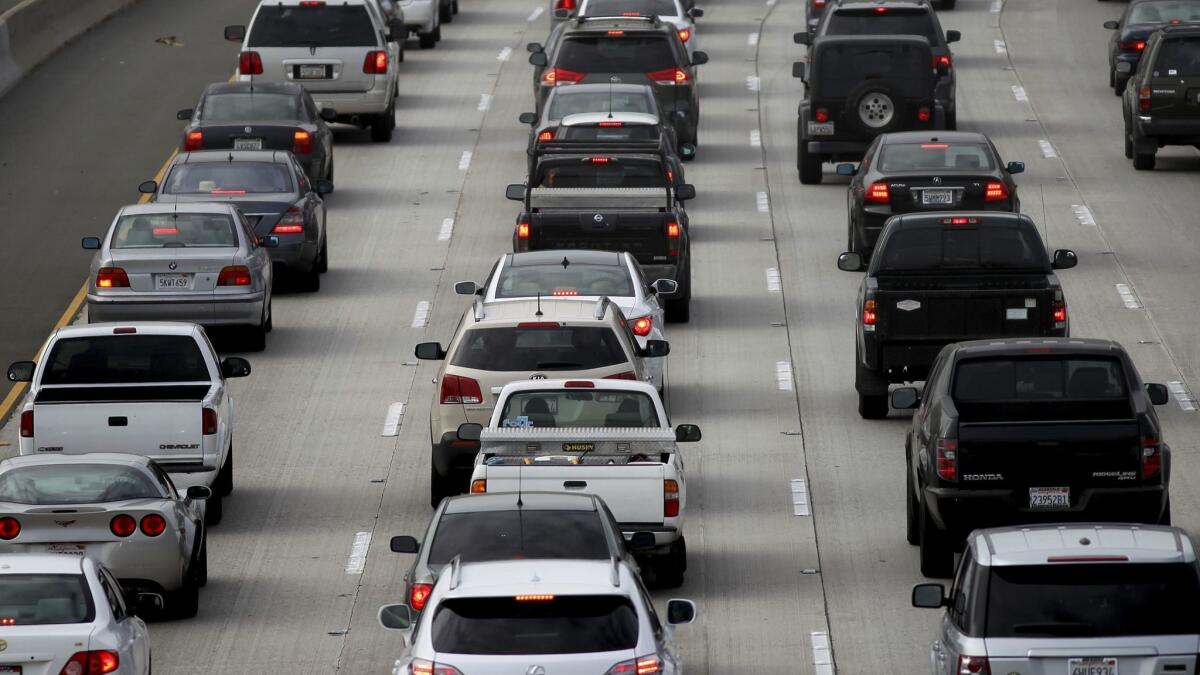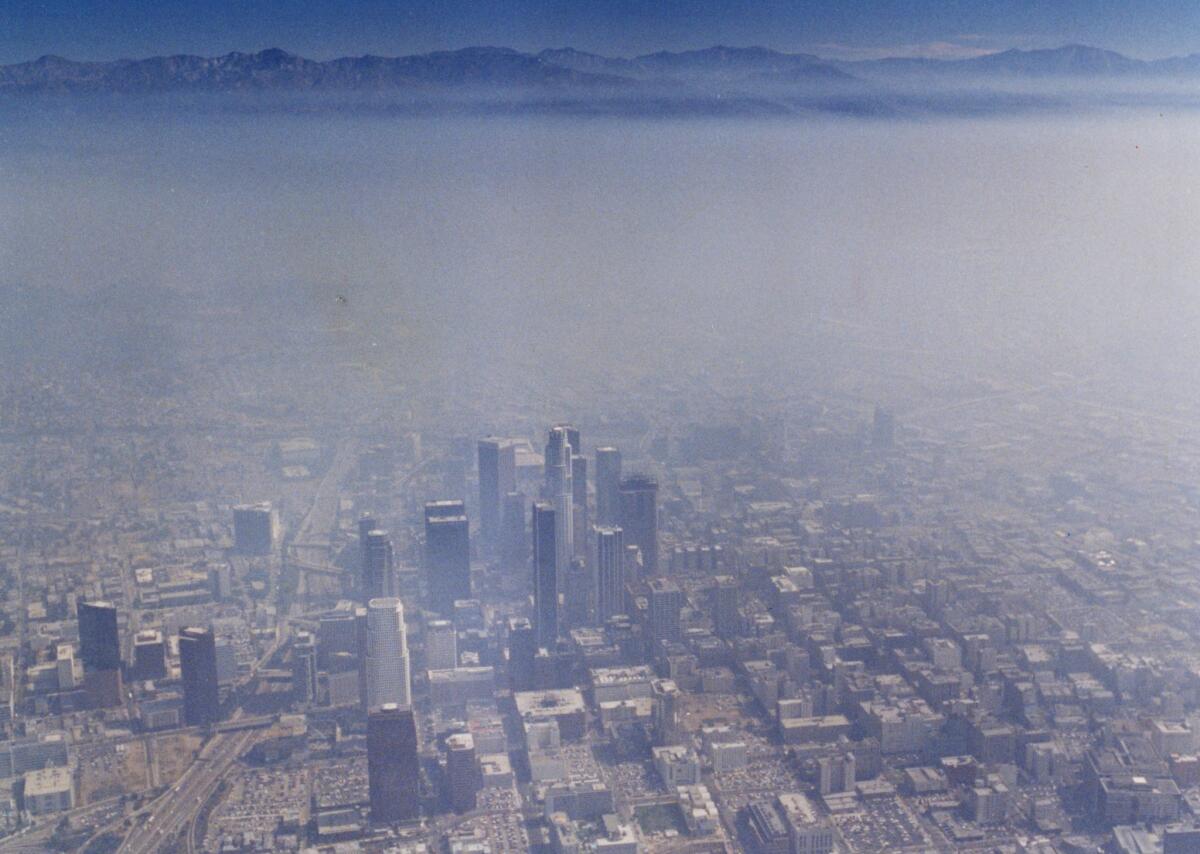Mad about L.A.’s air quality? Blame common products like hairspray and paint, not just cars

- Share via
When it comes to air quality, the products you use to smell nice or keep your kitchen clean could do just as much damage as the car you drive. A new study of the air around Los Angeles finds that consumer and industrial products now rival tailpipe emissions as a source of harmful atmospheric pollutants.
The findings, published Thursday in the journal Science, reveal a shift in the balance of polluting power in cities — one that may prompt researchers and regulators to step up their focus on a wide range of goods such as hairspray, paint and deodorant.
“As we control some of the biggest sources in the past, other sources are emerging in relative importance, such as the use of these everyday chemical products,” said study leader Brian McDonald, a research chemist with the University of Colorado at Boulder and the National Oceanic and Atmospheric Administration.
“In some ways,” he pointed out, “this is a good news story.”
Air pollution is a leading cause of health problems worldwide. Exposure to ground-level ozone and particulate matter contributes to asthma, lung cancer, cardiovascular disease and other serious ailments, according to the World Health Organization. A report last year in the journal Lancet ranked air pollution fifth among risk factors to human health, behind malnutrition, poor diet, high blood pressure and tobacco use.
Much of the stuff in air pollution forms from reactions with volatile organic compounds, or VOCs, a wide range of carbon-based chemicals that easily escape into the air and that humans produce in huge amounts.
In the past, car exhaust was the predominant source of those man-made VOCs. That’s been especially true in Los Angeles, a freeway-laced land of long commutes that a few decades ago was wreathed in dark, heavy layers of smog.

But as restrictions on tailpipe emissions have tightened and automotive technology has improved, the amount of VOCs has dropped and the air has cleared substantially. (Cars still produce tons of carbon dioxide, an invisible greenhouse gas that scientists say is contributing to global warming, but that’s another story.) Scientists wanted to see what that evolution meant for L.A.’s air pollution profile.
“As the mix of chemicals in the atmosphere has changed, how is that impacting air quality in the region — and generally, in any urban environment?” asked study co-author Christopher Cappa, an environmental engineer at UC Davis.
Cappa and his colleagues looked at data on the contents of outdoor air to see what pollutants they would find. They soon noticed that levels of certain VOCs, such as ethanol and acetone, were far too high to be explained by vehicle emissions alone.
“That implies that there’s some other source,” he said.
So the scientists went looking for those sources.
They made highly sensitive chemical measurements of air in the Los Angeles area. They also pored over chemical production statistics from industry and regulatory agencies.
The work revealed that many common products — including pesticides, paints, printing inks, adhesives, cleaning agents and personal care items such as body spray and hairspray — were full of volatile organic compounds that could be released into the air.
Since many of these VOC-containing products are used indoors, the scientists reviewed previous research on the air quality of interior spaces. Sure enough, the indoor concentrations of VOCs from these products were roughly seven times higher than they were in ambient air.
The researchers think that some of those compounds were probably leaking out of those buildings and polluting the greater environment.
Putting all of this together to create a coherent portrait of air pollutant sources was no easy task, said John Seinfeld, an atmospheric chemist at Caltech who was not involved in the paper.
“It’s a landmark accomplishment to have done this,” Seinfeld said. “It will stand as an important piece of work.”
By weight, people use about 15 times more fuel than they do any of these VOC-filled products like deodorant and hand sanitizer.
And yet, even though they’re a tiny sliver of the petrochemical pie, consumer and industrial products emit roughly the same level of VOCs as fuel-burning vehicles.
Part of the problem is in the very nature of these household items, scientists said. While fuel is meant to be burned, the VOCs in many consumer products are meant to escape into the air.
“Many of the volatile chemical products that we use every day are intended to simply evaporate,” said study co-author Jessica Gilman, a research chemist with NOAA. “Think of using hand sanitizer in cold and flu season, scented products, the time spent waiting for paint, ink and glue to dry.”
All of these, she said, involve “waiting for these volatile chemical products to evaporate.”

Petroleum-based chemicals in products like soaps and paints are a major contributor to Los Angeles’ air pollution, a new study suggests.
The study authors pointed out that while U.S. regulations on VOC-containing products emphasize the need to mitigate the ozone and other toxins that are created when VOCs react in the atmosphere, those regulations currently exempt many chemicals that lead to secondary organic aerosols — which make up much of urban air pollution.
It’s not just a problem for Los Angeles. Though the study focused on the Southland, its conclusions could have implications for cities across the U.S., Seinfeld said — although they might have slightly different “atmospheric cocktails.”
“In Houston, there will be more emissions from large refineries and chemical plants that don’t exist in L.A.,” he explained. “In the southeast U.S., the air is influenced a lot by emissions from vegetation.”
This new work points to a need to adapt research, and perhaps tailor regulations, to the changing pattern of emissions in cities, said Alastair Lewis, a researcher at the University of York in England who was not involved in the research.
“As knowledge of VOC chemistry improves, it will become possible to develop more targeted approaches to reducing impacts,” Lewis wrote in a commentary that accompanied the study. “Prioritizing those VOCs with the greatest aerosol formation potential — for example, through reformulation of consumer products — would be one option. Industry sectors that have until now been left outside of VOC emissions controls may, in a cleaner electrified future, receive more direct attention from regulators.”
But figuring out exactly which VOCs are the most problematic will take more research, the scientists said.
Ravi Ramalingam, chief of the Consumer Products and Air Quality Assessment Branch of the California Air Resources Board, pointed out that the VOCs in consumer products have been regulated with an eye toward keeping toxic chemicals and ground-level ozone out of the air. Understanding their effects on fine particulate matter helps fill in the picture of air pollution, he said.
“We’re really pleased that this kind of work is going on and we’re looking forward to engaging with the research team,” Ramalingam said.
To read this article in Spanish, click here
Follow @aminawrite on Twitter for more science news and “like” Los Angeles Times Science & Health on Facebook.
MORE IN SCIENCE
Even with pledges to fight global warming, you’d better brace yourself for more extreme weather
Scientists take an atomic clock on the road and use it to measure the height of a mountain
In soil-dwelling bacteria, scientists find a new weapon to fight drug-resistant superbugs
UPDATES:
4:30 p.m.: This story has been updated with additional information, including comments from study leader Brian McDonald and from Ravi Ramalingam of the California Air Resources Board.
This story was originally published at 11:10 a.m.







